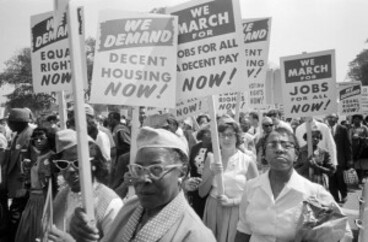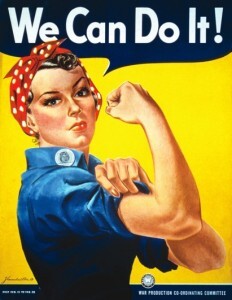
Celebrating Our Victories as we Move Forward for More - Part 2
Posted December 18, 2012 at 7:00 pm
By Osiris Gomez, ContributorThe Americans with Disabilities Act of 1990 (ADA) has made some significant strides, but more needs to be done. We need to keep pushing because areas that contribute to life satisfaction are still problematic, namely gainful employment.
“I would give anything in the world if I could work, but now it’s much more obvious that I am disabled,” said Deborah Lewis, who has fibromyalgia, in an interview with SHRM Online. “I can’t even get an application. No one wants to take a chance that something might happen to me and that I would sue them.”
“So many employers are missing out on well-educated people just because they don’t fit into their image of what an employee should look like, act like or sound like,” she added.
Deborah is not alone. There are thousands of competent and skilled Americans in the labor market that are unemployed.

The following is an excerpt from a report by Elaine Katz, Vice President of the Kessler Foundation, who oversaw the completion of an in-depth survey of people with disabilities. This survey assessed the effectiveness of the ADA 20 years later:
“Education and political participation were the two areas where the gaps have narrowed. Employment, however, remains responsible for the largest gap between people with and without disabilities. Among working-age people with disabilities, only 21 percent reported working either full- or part-time, compared with 59 percent of people without disabilities—a gap of 38 percentage points. This gap has decreased since it was first examined (from 43 percent in 1998), but it remains large and its decline has been slow. Moreover, this persistent gap impedes progress in other key areas for people with disabilities, such as income, access to health care, and socialization. The second largest gap was in a new indicator, Internet usage—85 percent vs. 54 percent for people with disabilities, a difference of 31 points. This was followed by indicators of lower income and greater financial struggles among people with disabilities.”
“Over the past two decades, we have seen gains in public awareness and access for people with disabilities, as well as advances in medical care and rehabilitation. These survey findings show that much still needs to be done to ensure that these gains translate into improvement in areas that contribute to life satisfaction. Clearly, passage of legislation is just the first step toward ensuring equal rights. As with the Civil Rights Act of 1964, legislation needs public support to achieve its goal.”
“This is an important step toward a national effort to expand employment opportunities for the country’s largest minority. To narrow the gaps that have persisted for 20 years, cooperative efforts from disability organizations, the business community, and government will be required. On the national level, we need to promote the talents of people with disabilities, reinforce their value in the workplace, and expand our networks with employers to ensure that a diverse workplace includes people with disabilities.”

“People with disabilities represent a critical talent pool that is underserved and underutilized,” says Shirley Davis, director of global diversity and inclusion at the Society for Human Resource Management, as reported by Pamela Babcock. Many are confident in this and are taking action. Steps are being taken at the university sector to develop the managerial skills of leaders with disabilities. The UCLA Leadership Institute for Managers with Disabilities aims to help mid-career professionals with disabilities catapult their careers to the next level. This unique program develops “leadership styles and skills, mentoring and personal development, organizational savvy, and strategic leadership.” President Barack Obama has taken action as well. In 2010, he passed an executive order to hire more people with disabilities in the public sector. He wants to use the American government to lead the way and set the example for the rest of the country.
But ultimately, the push for more opportunities for people with disabilities beyond the realm of entry-level staffing will be led by those at the top of the corporate hierarchy. According to Nadine O. Vogel, president at Springboard Consulting, these issues have yet to be felt at senior management positions of a great deal of American companies.
Each of us, in the public, can do our part to end this discrimination. It is hurting the life satisfaction of a major portion of our population. Although the ADA has helped, we must learn from history. We cannot settle for anything less than the best for each other.
The most successful movements in American history were driven by ordinary people that didn’t settle. The fight for womens’ suffrage and rights, abolition of slavery, Racial equality and civil rights in the 50s and 60s. The fight for disabled rights is no different. We can learn from history as we move forward with an understanding that great social change takes a great deal of time, dedication and patience. Not taking away from the importance and influence of the bill, the ADA should be built upon and is a stepping stone for greater things to come.

Let’s look back and reflect on the civil rights movement. Was the 15th Amendment enough for people who wanted racial freedom and equality? Sure, it gave the right to vote to ex-slaves, but this 1870 amendment did not squash racism. In 1955, Brown v. Board established that separate public schools for black and white students were unconstitutional. This was a landmark case that served to be a crushing blow to the Jim Crow status quo. But what if it stopped there? Was discrimination over because of the law? What if people settled for that, knowing more could be done? We wouldn’t have Martin Luther King Jr. delivering his “I Have A Dream” speech and leading boycotts. We wouldn’t have the Greensboro sit-ins. We wouldn’t have the landmark 1964 Civil Rights Act. People did not settle, they knew well that they had a fight that would take many years.
The fight for womens’ rights was no cakewalk, either. It took nearly 72 years after the 1848 Seneca Falls Convention for women to get the right to vote with the 19th amendment passed in 1920. Even after that, women were discriminated against in the workplace. The feminist movement helped to increase opportunity and fight against the glass ceiling in the workplace. Even today, women face challenges in the workplace.
I must echo Elaine Katz when she asserts that legislation needs public support achieve its goal. I believe that if we continue to push on together for disability we can achieve unimaginably greater things.

References:
- Kessler Foundation/National Organization on Disability. The 2010 Survey of Americans With Disabilities. http://www.2010DisabilitySurveys.org. Accessed August 17, 2010.
- Obama B. Executive Order: Increasing federal employment of individuals with disabilities. July 26, 2010. Available at http://www.whitehouse.gov/the-press-office/executive-order-increasing-federal-employment-individuals-with-disabilities. Sept 9, 2010.
- “Has the Americans with Disabilities Act Made a Difference?” http://www.shrm.org/hrdisciplines/Diversity/Articles/Pages/HastheADAMadeaDifference.aspx. July 9, 2010.
- Babcock, Pamela. “Targeted Development for Managers with Disabilities.” http://www.shrm.org/hrdisciplines/Diversity/Articles/Pages/ManagerswithDisabilities.aspx. July 21, 2010.

Comments
Add a comment